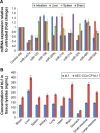Oral administration of encapsulated bovine lactoferrin protein nanocapsules against intracellular parasite Toxoplasma gondii
- PMID: 26504384
- PMCID: PMC4605239
- DOI: 10.2147/IJN.S85286
Oral administration of encapsulated bovine lactoferrin protein nanocapsules against intracellular parasite Toxoplasma gondii
Erratum in
-
Erratum: Oral Administration of Encapsulated Bovine Lactoferrin Protein Nanocapsules Against Intracellular Parasite Toxoplasma gondii [Corrigendum].Int J Nanomedicine. 2020 Sep 16;15:6871-6872. doi: 10.2147/IJN.S278906. eCollection 2020. Int J Nanomedicine. 2020. PMID: 32982238 Free PMC article.
Abstract
Toxoplasma gondii is a deadly intracellular parasite known to reside in every nucleated cell and known to cause severe complications in immunocompromised host. Standard drugs are cost effective and cause side effects, therefore, there is a necessity for a new drug molecule with immunomodulatory potential. Lactoferrin (Lf) is a natural milk protein, which has shown antimicrobial properties in its nanoformulation using alginate chitosan calcium phosphate bovine lactoferrin nanocapsules (AEC-CCo-CP-bLf-NCs). The present study was aimed to analyze and compare the effect of bovine Lf (bLf) in its native as well as nanoformulation (AEC-CCo-CP-bLf-NC) against coccidian parasite T. gondii. In vitro analysis has shown a significant increase in nitric oxide production and low parasitemia in in vitro cell culture model. In vivo BALB/c mice model have been used to develop human toxoplasmosis model. After treatment with NCs it has substantially increased the bioavailability of the protein and showed comparatively increased levels of reactive oxygen species, nitric oxide production, and Th1 cytokine which helped in parasite clearance. The mechanism of action of NCs has been clarified by immunoreactivity analysis, which showed accumulation of Lf in macrophages of various visceral organs, which is the site of parasite multiplication. Effect of NCs has significantly decreased (P<0.05) the parasite load in various organs and helped survival of mice till day 25 postinfection. Fe metabolism inside the mice has been found to be maintained even after administration of mono form of Lf, this indicates novelty of Lf protein. From the present study we concluded that nanoformulation did not reduce the therapeutic potential of Lf protein; however, nanoformulation has enhanced the stability of the protein and shown anti-toxoplasmal activity. Our study presents for the first time nanoformulation of Lf protein against Toxoplasma, which has advantages over the standard drug therapy without any side effects.
Keywords: Toxoplasma gondii; ceramic nanocapsules and reactive oxygen species; cytokines; immunoreactivity; nanocapsules; oral delivery; parasite load.
Figures







References
-
- Gaddi PJ, Yap GS. Cytokine regulation of immunopathology in toxoplasmosis. Immunol Cell Biol. 2007;85(2):155–159. - PubMed
-
- Alcantara CS, Yang C-H, Steiner TS, et al. Interleukin-8, tumor necrosis factor-α, and lactoferrin in immunocompetent hosts with experimental and Brazilian children with acquired cryptosporidiosis. Am J Trop Med Hygiene. 2003;68(3):325–358. - PubMed
-
- Petersen E, Schmidt DR. Sulfadiazine and pyrimethamine in the postnatal treatment of congenital toxoplasmosis: what are the options? 2003. Expert Rev Anti Infect Ther. 2003;1(1):175–182. - PubMed
-
- Kanwar JR, Kanwar RK, Sun X, et al. Molecular and biotechnological advances in milk proteins in relation to human health. Curr Protein Pept Sci. 2009;10(4):308–338. - PubMed
Publication types
MeSH terms
Substances
LinkOut - more resources
Full Text Sources
Miscellaneous

